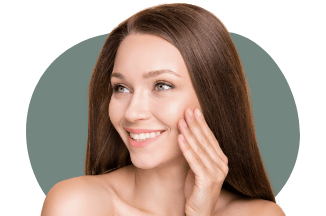Diet and the skin
Diet is known to have an influence over the skin. The connection between the consumption of various foods and their effect on our skin is complex and individual, remembering our skin stretches over the entire body.
Diets of individuals which are high in processed foods and sugars are often more predisposed to advanced skin ageing and poorer skin health. The effect of diets abundant in processed foods and high sugar result in inflamed, unhealthy skin which lacks essential nutrients described below for adequate function and skin health longevity.
First and foremost for optimal skin health adequate water consumption is essential. Water plays a necessary role in most cellular functions. Aside from the obvious benefits of improving hydration on a cellular level, water contains trace elements such as copper, iron, iodine and zinc. These trace elements have been found to influence skin immunity, inflammation and balance. Levels of zinc are often highest in skin tissue, serving to assist with skin cell growth and differentiation. The effect of copper in the skin results in better skin support (extracellular matrix formation; a semi-fluid gel around our cells), skin protein synthesis and new blood vessel creation. These effects collectively improve skin elasticity and healing capabilities.
Additionally, the consumption of various vitamins in our diet can replenish the health of our skin. Vitamins such as A, B, C and E are all consumed through our a well balanced diet containing a variety of fruits and vegetables. Their roles vary, however the common denominator is that all vitamins serve as antioxidants; the antidotes to cellular damage. Antioxidants neutralise the highly unstable and reactive molecules called free radicals from further cellular destruction.
The inclusion of protein in our diets provide our skin cells the capacity to renew and repair. Proteins are the building blocks to which construct our cells, tissues and organs, therefore are deemed crucial for cellular health and longevity.
UV exposure and the skin
Ultraviolet (UV) radiation generated by our sun is the primary environmental contributor of external skin ageing. There are three respective wavelengths namely, UV-A, UV-B and UV-C.
The most common being UV-A and UV-B. Chronic exposure to ultraviolet radiation ultimately leads to molecular, cellular and genetic changes in the skin therefore super-imposing the normal process of ageing.
UVB rays travel no further than the surface layers of our skin and are responsible for the sunburn we see. UVB rays are directly absorbed by our cells DNA, critically damaging the very blueprint keeping our cells healthy and functional. The DNA in our mitochondria (cellular powerhouses) are also subject to the UVB damage and have been found to be more vulnerable with fewer repair mechanisms to counteract this damage. Mitochondrial dysfunction will contribute to free radical production already being generated by ultraviolet radiation, creating a vicious cycle. Our mitochondria are essential to our skins health through regulating programmed cell death in response to damaging stimuli such as free radicals. Therefore constant threat to them can result in skin disease and dysregulation. Alternatively, UVA rays travel deeper into the skin, passing the surface and entering the deeper layers where our skins scaffolding lies, keeping it plump and strong. These rays contribute to the premature ageing of our skin when exposed to chronic amounts. Lastly, UVC rays although not commonly reaching earths surface from the sun, can be produced from UV sanitising bulbs, mercury lamps and welding torches. UVC interaction with the skin does not elicit as much damage to the skin unlike UVA and UVB.
It is important to remember, short bouts of UV is safe for the skin, it is the prolonged, long term exposure that causes damage. Below are some top tips to keep in mind when out in the sun:
- UV is strongest during 10-3pm, there are many mobile apps that can keep you UV safe
- UV is stronger during the summer months than in the winter months
- UV is strongest closer to the equator
- UV reaches us more when at higher altitudes
- Even on a cloudy day UV radiation can reach the ground, so it is important to always wear your SPF
- UV can reflect off surfaces; water, snow, sand, windows, mirrors
Occupations and the skin
The type of occupation you have may have an effect on your skin, especially if you are a night shift worker. During the evening the skins barrier has been found to be more vulnerable as it undergoes more regeneration and repair when compared to the day time. These effects are very much related to our bodies circadian rhythm. The circadian rhythm is an in-built cycle within us, governed by light and darkness in our environment. It is responsible for our bodily changes such as; heart and respiratory rates, production of hormones, brain activities, body temperature, tissue repair and healing.
Other occupational influences on our skin also include, artificial air-conditioning or heating, outside element exposure and chemical exposure.
Some occupations can also lead to compromised skin health; hair dressers coming into contact with chemicals and water often, nurses and doctors who routinely wash their hands, gardeners are more exposed to UV radiation daily, cleaners are more exposed to chemicals, construction workers are more commonly exposed to friction damage and even UV radiation.
Occupational exposure can occur with:
- Chemicals
- Oils
- Rubbers
- Resins
- Dyes
- Cements
- Biological
- Animal products
- Human products
- Plant products
- Physical
- Mechanical trauma
- Thermal trauma
- Environmental trauma (humidity, heat, cold, UV radiation)
- Ionising radiation
Pollution and the skin
Ambient air pollution is around us everyday, without notice. The combination of these toxic pollutants from motor vehicles, industrial facilities, fossil fuels, smog and more have been found to disrupt our skin as it is the only interface between the outside world. These toxins generate harmful free radicals which inflict damage to our skin cells. For example, ultra-fine particles associated with exhaust fumes are small enough to penetrate the skins surface and integrate themselves in our cells powerhouse- the mitochondria. These noxious particles rapidly deplete our reservoir of antioxidants in our skin, continuously fighting to neutralise the free radical damage occurring. A decline in antioxidants leads to increased skin ageing and higher incidence of skin disease.
Stress and the skin
Stress manifestation and perception is different for each person and therefore will present varied. The skins response to stress is complex results in immune function alterations, poor wound healing, disrupted barrier function and an impaired resistance to infection.
How does this all occur? The skin is a highly active organ, communicating with both the inside and outside environment through immune cells, hormones and neurotransmitters directing various skin specific cells to respond accordingly.
Short lived episodes of stress will activate many hormones and nervous signals to assist our body in fighting or adapting its way through danger, whereas long term episodes of stress may cause disruption to the usual adaptions therefore leading to disease. Stressed skins are more likely to display signs of heightened inflammation and present red, flushed, itchy, dry, thickened and irritated.
Genetics and the skin
Genetics play a role in our skins development before we are even born. You may also be predisposed to a genetic skin condition which might be known before birth.
Genetics are responsible for determining our skin’s Fitzpatrick skin type and the hydration levels (dry, oily, normal). Ageing, skin laxity, vein formation and discolouration are also related to our genetic make-up. Sometimes genetics may require a combination of factors to predispose a person to a condition like skin cancers. Not only do they rely on genes but also UV exposure.
Although we may think we will be predisposed to a particular skin condition ultimately it also comes down to how well you protect your skin’s health.

